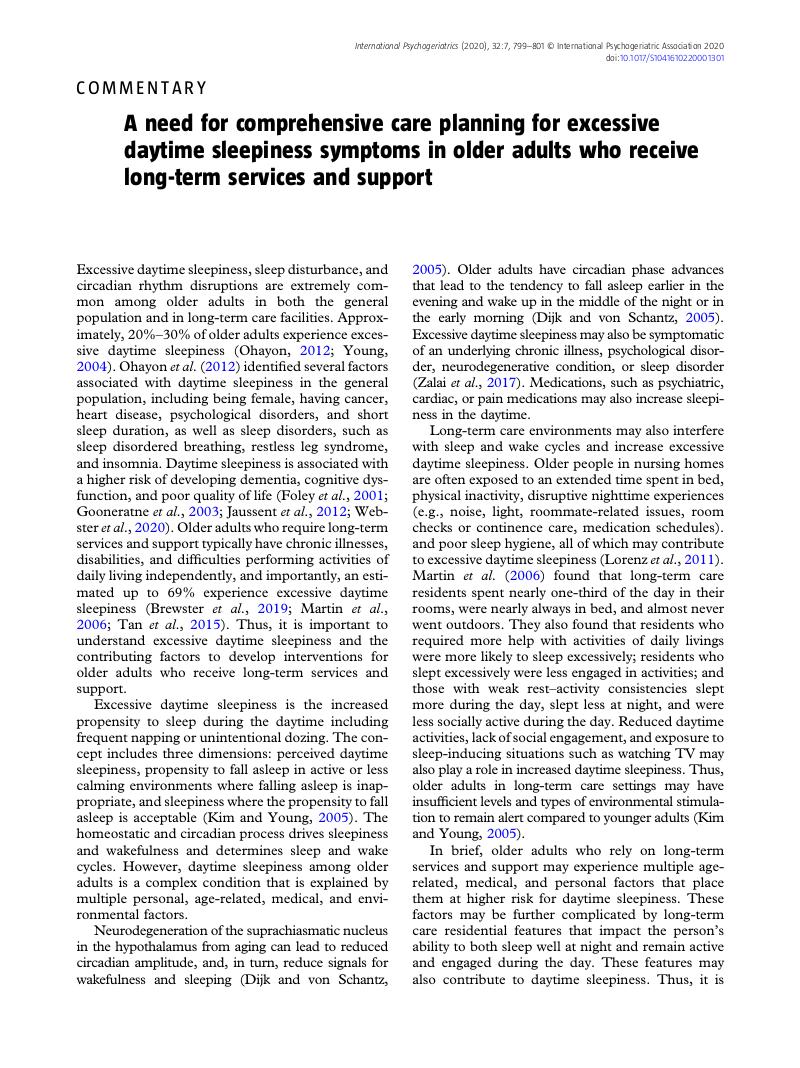No CrossRef data available.
Article contents
A need for comprehensive care planning for excessive daytime sleepiness symptoms in older adults who receive long-term services and support
Published online by Cambridge University Press: 03 August 2020
Abstract
An abstract is not available for this content so a preview has been provided. Please use the Get access link above for information on how to access this content.

- Type
- Commentary
- Information
- International Psychogeriatrics , Volume 32 , Issue 7: Issue Theme: Sleep and Sleep Disorders in Older Adults , July 2020 , pp. 799 - 801
- Copyright
- © International Psychogeriatric Association 2020
References
Brewster, G. S.et al. (2019). Association of health related quality of life domains with daytime sleepiness among elderly recipients of long-term services and supports. Geriatric Nursing (New York, NY), 40(4), 417–423. doi: 10.1016/j.gerinurse.2019.01.006CrossRefGoogle ScholarPubMed
Dijk, D.-J. and von Schantz, M. (2005). Timing and consolidation of human sleep, wakefulness, and performance by a symphony of oscillators. Journal of Biological Rhythms, 20(4), 279–290. doi: 10.1177/0748730405278292CrossRefGoogle ScholarPubMed
Foley, D.et al. (2001). Daytime sleepiness is associated with 3-Year incident dementia and cognitive decline in older Japanese-American men. Journal of the American Geriatrics Society, 49(12), 1628–1632. doi: 10.1111/j.1532-5415.2001.49271.xCrossRefGoogle ScholarPubMed
Gooneratne, N. S.et al. (2003). Functional outcomes of excessive daytime sleepiness in older adults. Journal of the American Geriatrics Society, 51(5), 642–649. doi: 10.1034/j.1600-0579.2003.00208.xCrossRefGoogle ScholarPubMed
Jaussent, I.et al. (2012). Excessive sleepiness is predictive of cognitive decline in the elderly. Sleep, 35(9), 1201–1207. doi: 10.5665/sleep.2070CrossRefGoogle ScholarPubMed
Kim, H. and Young, T. (2005). Subjective daytime sleepiness: dimensions and correlates in the general population. Sleep, 28(5), 625–634. doi: 10.1093/sleep/28.5.625CrossRefGoogle ScholarPubMed
Lorenz, R. A., Harris, M. and Richards, K. C. (2011). Sleep in adult long-term care (Chapter 21). In: Redeker, N. S. and McEnany, G. P. (Eds.), Sleep Disorders and Sleep Promotion in Nursing Practice. Springer Pub. Co.Google Scholar
Martin, J. L., Webber, A. P., Alam, T., Harker, J. O., Josephson, K. R. and Alessi, C. A. (2006). Daytime sleeping, sleep disturbance, and circadian rhythms in the nursing home. The American Journal of Geriatric Psychiatry, 14(2), 121–129. doi: 10.1097/01.JGP.0000192483.35555.a3CrossRefGoogle ScholarPubMed
Ohayon, M. M. (2012). Determining the level of sleepiness in the American population and its correlates. Journal of Psychiatric Research, 46(4), 422–427. doi: 10.1016/j.jpsychires.2011.06.008CrossRefGoogle ScholarPubMed
Petrovsky, D. V.et al. (2020). Predictors of changes over time in subjective daytime sleepiness among older adult recipients of long-term services and supports. International Psychogeriatrics, 32, 849–861. doi: 10.1017/S1041610220000782Google Scholar
Tan, E. C. K.et al. (2015). Analgesic use and daytime sleepiness in residents with and without dementia in residential aged care facilities. Drugs & Aging, 32(12), 1045–1053. doi: 10.1007/s40266-015-0325-2CrossRefGoogle ScholarPubMed
Young, T. B. (2004). Epidemiology of daytime sleepiness: definitions, symptomatology, and prevalence. The Journal of Clinical Psychiatry, 65(Suppl 16), 12–16.Google ScholarPubMed
Webster, L., Powell, K., Costafreda, S. G. and Livingston, G. (2020). The impact of sleep disturbances on care home residents with dementia: the SIESTA qualitative study. International Psychogeriatrics, 32, 839–847. doi: 10.1017/S1041610220000642Google Scholar
Zalai, D., Bingeliene, A. and Shapiro, C. (2017). Sleepiness in the elderly. Sleep Medicine Clinics, 12(3), 429–441. doi: 10.1016/j.jsmc.2017.03.015CrossRefGoogle ScholarPubMed


